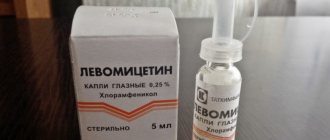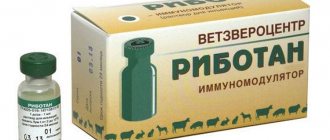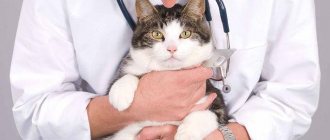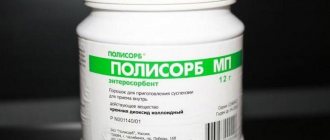The most effective antibacterial drug “Azithromycin” for cats is used to cure various infectious pathologies in animals. The medicine is sold in the form of tablets, capsules and suspensions for oral administration. An antibiotic should be given to your pet strictly as prescribed by a veterinarian, who will determine the dosage based on the results of a diagnostic examination. It is strictly contraindicated to prescribe Azithromycin to a kitten on your own, as this can lead to serious complications.
Diseases of dogs that should be treated with azithromycin
According to the instructions, azithromycin-based drugs are used by veterinarians to treat a wide range of bacterial infections in dogs and cats, including streptococci, staphylococci, Bartonella henselae, some species of Chlamydia, haemophilus spp., Mycoplasma spp., Borrelia burgdorferi and others.
The mechanism of action of azithromycin is associated with the P-subunit of 50S ribosomal RNA of those microorganisms that are susceptible to it, thereby interrupting the synthesis of RNA-dependent protein of the microorganism. Which leads to the death of the microorganism.
Instructions for use
In the process of scientific research conducted under the guidance of Doctor of Veterinary Sciences Litvinenko Yu. V., it was possible to establish effective dosages of the antibacterial drug Azithromycin for cats of various body weights. Thus, the dosage is calculated as follows: per 1 kg of pet’s weight, 5-15 mg of medication is required, depending on the diagnosis and the well-being of the sick pet. Frequency of administration - no more than 2 times, always at equal intervals, which is 12 hours. The duration of the treatment course is 5 days, but at the discretion of the veterinarian, the period for the cat to receive Azithromycin can be extended to 1-2 weeks.
What antimicrobial drugs are used in dogs?
- Trichopolum for dogs (instructions for use, doses, indications and contraindications)
- Explore the breadth of the antibacterial effect of ceftriaxone in dogs
- Instructions for use of Metrogyl for dogs
- Instructions for use of metronidazole for dogs. Study the breadth of the antibacterial effect of metronidazole in dogs. Calculate the optimal dose of the drug. Improve therapy effectiveness by 160%
- Instructions for use of clindamycin for dogs (Clindamycinum). Study the breadth of the antibacterial effect of clindamycin in dogs. Calculate the optimal dose of the drug. Improve therapy effectiveness by 100%
- Doxyfine for dogs (instructions for use, doses, indications and contraindications)
- Instructions for the use of doxycycline in dogs. Indications and contraindications, drug interactions, side effects. Treat dogs more effectively with doxycycline-based medications
- Atovaquone for dogs
For chronic bronchitis
Bronchitis is an inflammation of the mucous membrane and submucosal tissue of the bronchi. According to the flow there are:
- spicy;
- Chronical bronchitis.
Reference. The chronic disease is acquired as a result of ineffective treatment of acute bronchitis.
Choosing an antibiotic for the treatment of lower respiratory tract infections is a rather difficult task; moreover, the range of drugs for animals is extremely scarce, so drugs intended for humans, for example Sumamed, are often used.
In order to select the optimal dosage, the veterinarian needs to conduct a series of studies and identify potential causative agents of the disease.
This is not possible at home, so at the first signs of bronchitis (cough, wheezing, heavy breathing, fever), you need to contact a specialist and he will prescribe a course of treatment for the dog.
Reference. Bronchitis and pneumonia mostly affect hunting dogs. The disease is especially severe in puppies and old dogs.
Many owners of tailed animals note positive dynamics after the first doses of Sumamed. For large breeds (from 5 kg) 10 mg is recommended. per 1 kg. weight, for small breeds - 5 mg. per 1 kg. live weight. The duration of treatment varies from 5-7 days, depending on the severity of the disease.
Possible side effects of azithromycin in dogs
According to the prescribing information, the most common potential side effects associated with azithromycin include gastrointestinal problems
, such as abdominal discomfort, vomiting and diarrhea. Angioedema and jaundice can also occur as a result of taking azithromycin in dogs, although the chances of such complications are quite rare. More serious potential side effects may include cardiac arrhythmia, ventricular tachycardia, and problems with kidney function in dogs.
Composition and action: what are the features?
The antibacterial drug "Azithromycin" consists of the active substance of the same name - azithromycin, which belongs to the group of macrolides that have a bacteriostatic effect. This means that the main component, by inhibiting protein production, suppresses the growth of pathogenic cells, after which they lose the ability to reproduce and develop. As a result, the causative agents of the infectious disease die and are naturally eliminated from the cat’s body. The antibiotic is active against a wide range of microbes. Its components are quickly absorbed through the intestinal walls, reaching maximum concentration after 1-2 hours.
Azithromycin does not accumulate in the blood, but is localized in the tissues and directly at the site of infection. In addition, it has a unique ability to detect the epicenter of pathogenic agents, which is what distinguishes it from other drugs of similar action, which are evenly distributed throughout all tissue structures and fluids. It is also important that the antibiotic acts not only outside, but also inside pathogenic cells. Thanks to this ability, Azithromycin acts on intracellular parasites, including chlamydia and mycoplasma.
During drug therapy, the animal’s gastrointestinal tract is practically not affected.
Plus, azithromycin has a significant advantage - it cannot be destroyed by gastric juice and practically does not provoke side effects from the gastrointestinal tract. In general, the antibacterial drug has a mild, gentle effect on the cat’s body; it is considered less toxic and therefore suitable even for small kittens.
Drug interactions with azithromycin in dogs
The prescribing veterinarian should be made aware of any and all medications your pet is currently taking. You need to know this before prescribing azithromycin, because the drug may interact with other medications.
According to the label, general contraindications include ergotamine, dihydroergotamine, triazolam, pimozide, cisapride or other macrolide antibiotics, oral antacids, and any drugs metabolized by cytochrome P450 (eg, cyclosporine, hexobarbital, phenytoin, terfenadine, and carbamazepine).
Reviews from veterinarians
Smirnova N.A. - veterinarian, Moscow.
Sumamed is an antibiotic that contains azithromycin dihydrate. This drug is used for upper respiratory tract infections, lower respiratory tract infections, skin and soft tissue infections.
There are also contraindications for use: increased sensitivity to macrolide antibiotics.
Sumamed is active against gram-positive and gram-negative microorganisms. Used orally 1 time per day for 3-5 days. During this period of time, the dog recovers completely or partially.
Recommended for use after consultation with a specialist. In the Russian Federation, this drug has proven itself to be an effective and fairly safe remedy.
Nikolaev I.K. veterinarian Kaluga.
Over the years, the antibacterial drug Sumamed has proven itself to be a highly effective and fast-acting antibacterial drug that affects many microorganisms with high sensitivity.
In addition, this antibiotic has practically no pronounced side effects, which cannot but please doctors and dog owners.
Effective treatment is the key to a long and happy life for your four-legged pet. When choosing a medicine, you need to remember not only the benefits, but also the possible consequences and side effects, so be careful and careful.
What preparations of azithromycin should be used in dogs?
According to the instructions for use, the drug is only available with a prescription from a veterinarian. The trade name for the human drug is Zithromax®, but the drug can be purchased at compounding pharmacies in tablet or powder form. The active substance in Latin is Azithromycin.
Giardia intestinalis infection is a common cause of diarrhea in humans and other mammalian species worldwide. This report describes a case in which a dog suffering from diarrhea caused by G. intestinalis was effectively treated with azithromycin. The drug in question is an azalide, semi-synthetic macrolide antibiotic that has a broad spectrum of action against bacterial pathogens and some protozoa. In this case, Giardia infection in the dog was confirmed by microscopic examination and PCR.
Sequencing of the detected Giardia amplicon confirmed infection by strain AI. The dog received azithromycin at a dose of 10 mg/kg orally once daily for 5 days.
After therapy, the diarrhea stopped. The effectiveness of the treatment was also confirmed using PCR and microscopic examination. This is the first report of the treatment of canine giardiasis with azithromycin. It appears that azithromycin may be considered a promising antibiotic for the control of Giardia infection in dogs.
The drug is effective in the treatment of piroplasmosis in dogs and other animal species
^Top
Azikan
Instructions
I. General information
1. Trade name of the drug: Azican.
International nonproprietary name: Azithromycin.8%.
2. Dosage form: solution for injection.
Azican contains 80 mg of active ingredient in 1 cm3 of solution.
Azithromycin in the form of dihydrate, and as auxiliary components: 20 mg of lidocaine hydrochloride, citric acid and sodium hydroxide in quantities necessary to correct pH = 6.0 and water for injection up to 1 cm3. 3. In appearance, Azikan is a transparent solution from colorless to slightly yellow.
The shelf life of Azikan, subject to storage conditions, is 2 years from the date of production. After the first opening of the bottle, Azikan must be used within 28 days.
Azikan should not be used after the expiration date.
4. Azikan is produced packaged in 5, 10, 20, 50 and 100 cm3 in dark glass bottles of appropriate capacity, sealed with rubber stoppers reinforced with aluminum caps. Bottles of 5, 10, 20 and 50 cm3 are packaged in individual cardboard boxes. Each packaging unit is supplied with instructions for use.
5. Azikan is stored in the manufacturer’s sealed packaging, separate from food and feed, in a dry place, protected from direct sunlight, at a temperature of 5°C to 25°C.
6. Azikan should be stored out of the reach of children.
7. Unused medicinal product is disposed of in accordance with legal requirements.
8. Dispensing conditions: without a veterinarian's prescription.
II.
Pharmacological (biological) properties 9. Azikan – Antibacterial drug from the azalide group.
v10. Azithromycin, which is part of Azikan, is a broad-spectrum antibacterial agent. Acts bacteriostatically.
By binding to the 50S ribosomal subunit, it inhibits peptide translocase at the translation stage, suppresses protein synthesis, slows down the growth and reproduction of bacteria, and in high concentrations has a bactericidal effect. Acts on extracellular and intracellular pathogens.
Azithromycin is active against:
gram-positive microorganisms: Streptococcus spp. Streptococcus pneumoniae, Streptococcus pyogenes, Streptococcus agalactiae, Streptococcus viridans, Staphylococcus epidermidis, Staphylococcus aureus; gram-negative bacteria: Haemophilus influenzae, Moraxella catarrhalis, Bordetella pertussis, Bordetella parapertussis, Legionella pneumophila, Haemophilus ducreyi, Campylobacter jejuni, Neisseria gonorrhoeae and Gardnerella vaginalis;
anaerobic microorganisms: Bacteroides bivius, Clostridium perfringens, Peptostreptococcus spp;
chlamydia and mycoplasmas: Chlamydia trachomatis, Chlamydia pneumoniae, Mycoplasma pneumoniae, Mycobacterium avium complex, Ureaplasma urealyticum, Treponema pallidum, Borrelia burgdorferi.
Pharmacokinetics: After intramuscular administration of Azikan, the bioavailability of azithromycin is 90%. The maximum concentration of azithromycin in the blood reaches a maximum after 2 hours. The half-life is 13-14 hours. Therapeutic concentration in the blood remains for at least 48 hours. Azithromycin is transported by phagocytes, polymorphonuclear leukocytes and macrophages to the site of infection, where it is released in the presence of bacteria.
In terms of the degree of impact on the body, Azikan is classified as a low-hazard substance (hazard class 4 according to GOST 12.1.007-76).
III.
Directions for use 11. Azikan is prescribed to dogs and cats for the treatment of diseases caused by microorganisms sensitive to azithromycin (infections of the respiratory and genitourinary systems, infectious diseases of the skin and soft tissues, etc.).
12. The use of Azikan is contraindicated in animals with hypersensitivity to antibiotics - macrolides. Use in animals with renal failure is not recommended due to available data on an increase in creatinine in response to high doses of the drug.
13. Azikan is used intramuscularly in dogs and cats.
A single dose is 1.0 cm3 per 10 kg of animal weight, which is equivalent to 8 mg of azithromycin per 1 kg of animal body weight.
The interval between injections is 48 hours.
In most cases, the course of treatment is two injections. In cases of severe disease, a third injection may be required.
14. Symptoms of overdose when using Azican in accordance with the instructions were not identified.
15. No peculiarities of action were identified when taking the drug for the first time and when it was discontinued.
16. Specifics of use in pregnant animals have not been established. The use of Azikan during lactation is not recommended, since the drug is excreted in milk.
17. Avoid skipping the next dose of the drug, as this may lead to a decrease in therapeutic effectiveness. If one or more doses of the drug are missed, treatment should be resumed as soon as possible at the prescribed dosage and regimen.
18. When Azican is used in accordance with the instructions, as a rule, no adverse reactions or complications are observed.
Possible pain and swelling at the injection site of Azikan. Depression, lethargy, refusal to feed, and lameness may occur. These phenomena disappear on their own within a few hours.
If allergic reactions occur, stop using the drug and, if necessary, prescribe antihistamines or other symptomatic treatment.
19. The use of Azikan does not exclude the use of symptomatic and pathogenetic therapy.
20. Drug interactions: Combined use with chloramphinecol and tetracycline antibiotics enhances the antibacterial effect of azithromycin.
Combined use with lincomycin leads to decreased effectiveness.
Possible increased toxicity of digoxin.
IV.
Personal preventive measures 21. When working with the drug, you should follow the general rules of personal hygiene and safety precautions provided for when working with medicinal products.
22. Smoking, drinking and eating are prohibited during work. After finishing working with the drug, wash your face and hands thoroughly with soap. Empty drug bottles must not be used for household purposes; they must be disposed of with household waste.
People with hypersensitivity to the components of the drug should avoid direct contact with Azikan.
23. If the drug gets on the skin or mucous membranes, rinse them immediately with plenty of water. If allergic reactions occur or if the drug accidentally enters the human body, you must immediately contact a medical facility (bring the instructions for use or label with you).
Registration certificate number RK-VP-4-3422-17
The mechanism of action of the drug azitronit
The mechanism of action is associated with inhibition of protein synthesis by microbial ribosomes (the formation of peptide bonds between amino acids and the peptide chain is disrupted).
Azitronite exhibits a long-lasting antibacterial effect in the body
- persistent inhibition of the vital activity of microorganisms after their short-term contact with an antibacterial drug. This pharmacological effect is based on irreversible changes in the ribosomes of the microorganism, resulting in a persistent translocation block. Due to this, the overall antibacterial effect of the drug is enhanced and prolonged, remaining for the period necessary for the resynthesis of new functional proteins of the microbial cell.
Azitronite is well absorbed and quickly distributed in the tissues of the body, reaching high concentrations many times higher than the concentration in the blood plasma. High antimicrobial activity is also ensured due to the ability of azitronite to penetrate and accumulate intracellularly in leukocytes (granulocytes and monocytes/macrophages), with which it is transported to sites of inflammation, as a result of which the concentration of the antibiotic is 6 times higher in the site of inflammation compared to intact tissues.
In terms of the degree of impact on the body, azitronite is classified as a low-hazard substance (hazard class 4 according to GOST 12.1.007-76).
Types of antibiotics for cats and rules for their use
Antibiotic therapy is common in veterinary medicine. Without antibacterial agents, not a single serious disease in cats and dogs can be treated. I want to talk about the basics of using antibiotics, in what cases it is worth using antibacterial agents, what types are used most often, indications and contraindications for use in cats. All the nuances will be discussed below.
Antibacterial agents are given in the presence of inflammatory processes in the cat’s body with the involvement of pathogenic or conditionally pathogenic microflora.
Antibiotics are widely used in veterinary medicine to treat diseases caused by pathogenic bacteria and fungi
List of indications:
- Dermatological infections accompanied by open wounds on the animal’s body
- Abscesses, cellulitis, open wounds with purulent exudate
- Urological problems
- Eye diseases - conjunctivitis, blepharitis, corneal ulcer, etc.
- Surgical interventions
- Ear diseases
- Severe infectious diseases. Relevant for unvaccinated cats
The use of antibacterial agents allows the cat to quickly recover from an inflammatory infection, heal wounds and restore its former health.
At the same time, new generation antibiotics, which are used in veterinary medicine, have fewer contraindications and consequences than first generation drugs.
https://www.youtube.com/watch?v=7ErilJsTdmo
This means that the animal will recover more quickly from inflammatory processes.
Thus, the animal can get dysbiosis.
When treating with antibiotics, it is very important to follow the correct dosage
Allergic reactions are not excluded. Therefore, the owner needs to carefully monitor their pets during the course of antibiotic therapy; if any side effects appear, the pet must be immediately shown to a veterinarian.
There are many antibacterial agents, which are divided into different groups, according to the main active ingredient, which is improved over time. Each group is active against many microorganisms, but works in a specific group of organs. Several titles.
Amoxicillin
Amoxicillin is an antibiotic of the penicillin group. It is considered a light drug that can overcome pathogenic microflora at the initial stages of its reproduction in the body. Fights inflammation of the urinary and respiratory tract. Helps in the treatment of dermatological diseases.
Amoxicillin is a broad-spectrum antibiotic
Prescribed in the postoperative period as a prevention of inflammatory processes in internal organs.
Azithromycin
Antibacterial drug from the macrolide group. It has a wide spectrum of action and is considered a long-lasting agent for combating pathogenic microflora.
Azithromycin
Capable of destroying infections in the respiratory tract, digestive tract, genitourinary system, dermatological diseases, fungal diseases.
Ceftriaxone
An antibiotic from the group of long-acting cephalosporins. It also has a wide spectrum of action.
Ceftriaxone
Prescribed for urinary tract infections, sepsis and severe lesions of the extremities (severe abscess, gangrene, purulent and putrefactive infection).
Terramycin
It can often be found in the form of an eye ointment. The drug is prescribed for the treatment of various inflammatory diseases of the visual apparatus.
It has a wide spectrum of action, but is not considered a long-term drug.
Lincomycin
An antibiotic from the lincosamide group. It is used mainly against infectious diseases of bones and muscles, as well as after operations related to bones and muscles. The injection is given intramuscularly.
It is considered a broad-spectrum antibiotic with prolonged action.
There is no need to prescribe antibiotics to your cat yourself or practice self-medication without a veterinarian’s prescription.
Illiterate use of antibacterial drugs can cause great harm to your pet.
Side effects include:
- The appearance of allergic reactions
- Diarrhea
- Long-term use may cause nausea, nervous system disorders,
If the medicine is prescribed by injection, it is advisable that the first injection is given by a doctor
Contraindications
- Pregnancy and lactation
- Chronic liver and kidney diseases with caution
- For kittens with caution
- The first dose is always a shock dose, that is, twice the usual dose.
Subsequently, the usual dose is prescribed - Dermatological diseases take a long time to treat, antibiotic therapy lasts up to several months, and with increased doses
- For diseases of external organs - wounds, otitis media, inflammatory eye diseases - local antibiotics are prescribed
- You should not take antibiotics if microflora cultures have been performed and the results are negative.
- Antibacterial agents must be continued for three days after the symptoms of the disease have disappeared.
- Taking antibiotics continues throughout the course, without interruption. If you stop the course of the prescribed drug, then all the existing microflora in the cat’s body will become resistant to the drug and it will not work in the future.
Proper use of antibacterial agents contributes to the speedy recovery of the cat’s body.
The use of antibiotics is not dangerous if used correctly.
Therefore, you should not be afraid if veterinarians prescribe drugs from this group to your furry pet, because with their help the disease will recede much faster.
Antibiotics are medications used to treat a variety of bacteria and microbes. Such medications cleanse the body of pathogenic microflora: protozoa, fungi and bacteria. They are also prescribed for prophylaxis in the postoperative period (for example, after sterilization).
Antibacterial drugs can be natural or synthetic in origin. They have a wide spectrum of action, and in addition to pathogenic microorganisms, they also kill beneficial microflora.
From this video you will learn how to understand that your cat has a viral infection, what the first symptoms of the disease may be, and how to provide first aid to your pet.
Antibiotics are divided into groups depending on their mode of action and form of release. Let's look at each group in more detail.
By type of action
According to the type of effect on microflora, antibiotics are:
- bactericidal – destroy harmful microorganisms;
- bacteriostatic – block pathogens. Such drugs have a milder effect. They prevent the development of bacteria. Pathogenic microflora dies on its own and is naturally eliminated from the body.
By release form
Depending on the form of release, antibacterial agents are of the following types:
- ointments, sprays and powders. Used to treat wounds and treat eyes (for example, purulent conjunctivitis). Have a local effect;
- tablets and injections. Used to treat systemic infections. Injected into the body;
- aerosols. Prescribed in the presence of respiratory tract infections;
- candles. Used to detect vaginitis and other ailments of the genitourinary system.
Similar article: How to properly use Milbemax for cats
Antibiotics can be prescribed to animals in the form of injections, ointments, sprays and tablets. Most often, the medicine is administered through injections. They are performed 2 times a day. Usually the drug is administered intramuscularly.
But sometimes the administration occurs intravenously or subcutaneously. The veterinarian determines where to inject. The method of use is also specified in the instructions. It also indicates the dosage for each specific case.
Each time the injection is performed with a new syringe. You can simply change the needle. Otherwise, it will become dull and will tear the tissues rather than move them apart, which will lead to pain.
Tablets are prescribed if for some reason the cat cannot be given injections. In this form, the medicine acts more harshly. Therefore, along with it, medications are prescribed that restore the intestinal microflora.
The tablet is divided into 4 parts before administration. The pet should be given ¼ part at a time. However, the dose can be increased as directed by your veterinarian. Fragments of the tablet are placed deeper on the side of the tongue.
Adult animals can be given the whole tablet. If a kitten is being treated, then the drug must be crushed. Capsule antibiotics can be mixed into sour cream. This way the medicine will be tastier to eat.
Antibacterial drugs have a wide spectrum of action and are prescribed for the treatment of a wide variety of pathologies:
- pyelonephritis;
- pneumonia;
- inflammatory processes of the genitourinary system;
- infectious diseases of the respiratory tract (for example, colds);
- leptospirosis;
- eye inflammation;
- intestinal infections;
- pseudomonosis;
- inflammation of wounds, injuries, abscesses;
- oncology;
- skin ailments.
Cats are also prescribed antibiotics for prophylactic purposes: after operations to minimize the risk of developing purulent complications, speed up the recovery period, etc.
Contraindications
The instructions for each antibiotic provide a complete list of contraindications. It is individual for each individual product. Typically, antibacterial drugs should not be given to animals with individual intolerance to the components, in the presence of kidney disease, or pregnancy. The ban also applies to very small pets.
Related article: Causes and treatment options for diarrhea in cats
Side effects
If a cat takes antibiotics in violation of the instructions specified in the instructions, the risk of developing side effects increases. After starting treatment, an exacerbation of the pet’s chronic ailments is possible. Due to an overdose or the duration of treatment, the animal may experience the following complications:
- swelling;
- vomit;
- muscle spasms;
- labored breathing;
- diarrhea;
- allergic manifestations (for example, rash);
- liver and kidney damage;
- hearing loss;
- secondary infections.
The most severe case will be anaphylactic shock. The duration and severity of adverse reactions depend on the type of medication, the stage of the disease, its complexity, and the general health of the cat.
Advantages
Regardless of their name, antibiotics have the following advantages:
- effective treatment with small doses of medication;
- the therapeutic effect manifests itself in a short time;
- low level of toxicity with proper dosage selection;
- broad-spectrum antimicrobial properties;
- removal of toxins released by pathogenic microflora;
- antibacterial properties are maintained in the presence of microorganisms.
Flaws
- Penicillins - produced by colonies of the mold Penicillinum; used for: Acute and chronic sinusitis; retropharyngeal abscess; otitis media; pneumonia; chronic bronchitis; urinary tract infections; · odontogenic infections, including periodontitis; gynecological infections; · infections of the skin and soft tissues (including wound infections); · infections of bones and joints; as a prevention of purulent-septic complications during surgical interventions on the pelvic organs, abdominal cavity, kidneys, heart, bile ducts; in the treatment of mixed infections that are caused by gram-positive and gram-negative microorganisms, as well as anaerobic pathogens (biliary tract infections, ENT infections and postoperative abdominal infections, aspiration pneumonia, breast abscess); Maxillofacial Surgery; orthopedic practice.
- Cephalosporins have a similar structure to penicillins. There are four generations of cephalosporins. Used against penicillin-resistant bacteria, the scope is the same.
- Macrolides are antibiotics with a complex cyclic structure. Macrolides are a class of antibiotics whose chemical structure is based on a macrocyclic lactone ring. They act on the pathogens of whooping cough and diphtheria, Moraxella, Legionella, Campylobacter, Listeria, spirochetes, chlamydia, mycoplasma, ureaplasma. The action is bacteriostatic, which means they do not kill, but inhibit the growth of bacteria at a certain level. Microorganisms of the family Enterobacteriaceae, Pseudomonas spp. and Acinetobacter spp. have natural resistance to all macrolides.
- Tetracyclines - used to treat respiratory and urinary tract infections, treatment of severe infections such as anthrax, tularemia, brucellosis. The action is bacteriostatic.
- Aminoglycosides are highly toxic. Currently, there are three generations of aminoglycosides. Aminoglycosides are of primary clinical importance in the treatment of nosocomial infections caused by aerobic gram-negative pathogens, as well as infective endocarditis. Streptomycin and kanamycin are used in the treatment of tuberculosis. The action is bactericidal.
- Levomycetins - chloramphenicol is active against strains resistant to penicillin, streptomycin, and sulfonamides. Resistance of microorganisms to chloramphenicol develops relatively slowly. In veterinary medicine it has proven itself well when applied topically. The action is bacteriostatic.
- Glycopeptide antibiotics disrupt the synthesis of bacterial cell walls. They have a bactericidal effect, but are bacteriostatic against enterococci, some streptococci and staphylococci.
- Lincosamides have a bacteriostatic effect, which is due to the inhibition of protein synthesis by ribosomes. In high concentrations, they can exhibit a bactericidal effect against highly sensitive microorganisms.
- Ceftriaxone dosage for cats
- How to take Azithromycin for cystitis in women
Pharmacological properties and effects
Azithromycin, the active pharmacological ingredient of a veterinary drug, has a bacteriostatic effect in low doses, and a bactericidal effect in high doses.
Azitronit shows high efficiency in the destruction of gram-positive microorganisms:
- Enterococcus faecalis
- Erysipelothrix insidiosa
- Listeria spp.
- Staphylococcus aureus
- Staphylococcus spp.
- Streptococcus pneumoniae
- Streptococcus pyogenes
- Streptococcus spp.
Azitronit is active against gram-negative microorganisms
— pathogens of infections in animals:
- Actinobacillus lignieresii
- Bordetella spp.
- Campylobacter spp.
- Escherichia spp.
- Haemophilus parasuis
- Haemophilus spp.
- Legionella pneumophila
- Mannheimia haemolytica
- Moraxella spp., Pasteurella multocida, Salmonella spp.
Azitronite acts on anaerobic bacteria:
- Clostridium perfringens
- Fusobacterium spp.
The drug is also active against:
- mycoplasmas Mycoplasma pneumoniae
- chlamydia (Chlamydia pneumoniae)
- spirochetes (Borrelia spp.)
Azitronite
, like other macrolides, is a bacteriostatic antibiotic that inhibits protein synthesis by binding to ribosomes. This drug has been found effective against a variety of different gram-positive and gram-negative bacterial pathogens in different species of domestic animals, and has some activity against anaerobic microorganisms. In addition to its activity against microorganisms, azithromycin has also been found to be effective against rickettsiae, spirochetes, and protozoa (eg, Toxoplasma gondii, Giardia spp., and Cryptosporidium spp.).
Azitronite is highly bioavailable after oral administration (PO) in dogs (97%), and is moderately bioavailable in cats (58%) and humans (37%). In dogs, single oral doses of 10 to 40 mg/kg provided proportionate tissue levels of the antibiotic. A 4- to 7-fold increase in tissue concentrations was observed in dogs following dosing.
Azitronite can accumulate both in polymorphonuclear cells and in macrophages in dogs, cats, horses, pigs and cattle.
These cells help the antibiotic penetrate the site of infection, an example of the synergistic effect of the immune system and the exogenous compound, azitronite, working together to control infection.
Overdose:
- anxiety
- temporary hearing loss
- disorientation
- sleep disorders
- increased activity of liver enzymes
In this case, it is necessary to stop administering the drug. There are no specific means of detoxification; general measures are used to remove the drug from the body and symptomatic therapy.
Contraindications to the use of the drug AZITRONIT® in cats, dogs, pigs, cattle:
- lactation period;
- liver failure;
- hypersensitivity to macrolide antibiotics
- renal failure
Indications for veterinary use of the drug AZITRONIT®
For cats, dogs, cattle, sheep and pigs for the treatment of bacterial infections caused by microorganisms sensitive to azitronite, including:
- skin and soft tissue infections
- genitourinary system infections
- respiratory infections
- digestive system infections
- mycoplasma infections
- necrobacteriosis
- pig mug
- spirochetosis
Since this antibiotic can be delivered to inflamed tissues by migration of leukocytes, it has a significant advantage over other classes of antibiotics.
Some macrolide antibiotics have been found to have anti-inflammatory activity. Although the exact mechanism of this effect is unknown. There is an assumption that azitronite is able to inhibit the production of pro-inflammatory mediators and cytokines. Of the 4 macrolides tested to evaluate the anti-inflammatory effect (roxithromycin, clarithromycin, erythromycin and azithromycin), azitronit had the weakest effect on the anti-inflammatory response.











